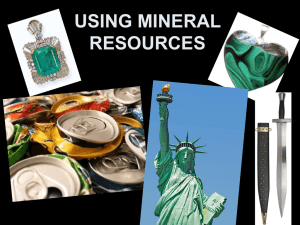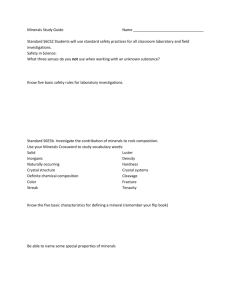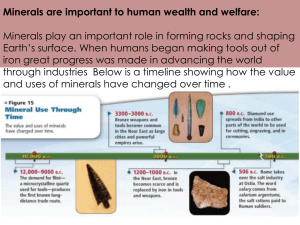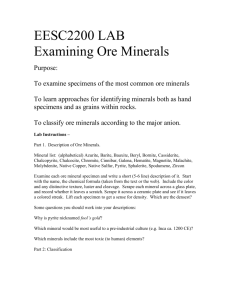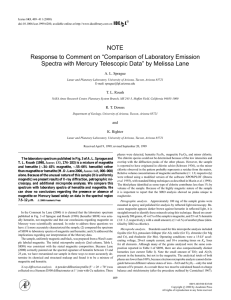Ores and Economic Minerals
advertisement
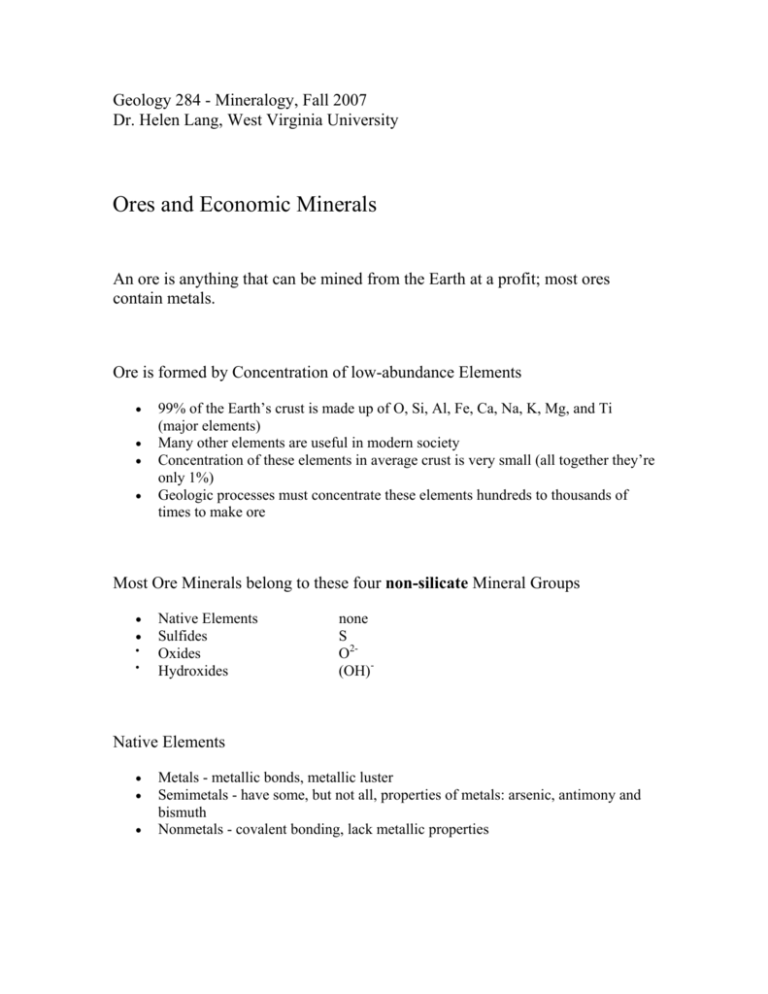
Geology 284 - Mineralogy, Fall 2007 Dr. Helen Lang, West Virginia University Ores and Economic Minerals An ore is anything that can be mined from the Earth at a profit; most ores contain metals. Ore is formed by Concentration of low-abundance Elements • • • • 99% of the Earth’s crust is made up of O, Si, Al, Fe, Ca, Na, K, Mg, and Ti (major elements) Many other elements are useful in modern society Concentration of these elements in average crust is very small (all together they’re only 1%) Geologic processes must concentrate these elements hundreds to thousands of times to make ore Most Ore Minerals belong to these four non-silicate Mineral Groups • • • • Native Elements Sulfides Oxides Hydroxides none S O2(OH)- Native Elements • • • Metals - metallic bonds, metallic luster Semimetals - have some, but not all, properties of metals: arsenic, antimony and bismuth Nonmetals - covalent bonding, lack metallic properties Principal Native Metals • • • • • • Gold (Au) Silver (Ag) Copper (Cu) Platinum (Pt, rarest and most valuable) All have cubic arrangement of atoms Habits: massive, leaf, wire-like, arborescent Gold Copper Crystal, very unusual Native Non-metals • • • • Sulfur (S) Graphite (C) – Low pressure polymorph of Carbon – Diamond (C) – High pressure polymorph of Carbon >30kbar – Formed deep in the Earth’s mantle >90km – Brought to the surface by violent, explosive igneous eruptions of magmas called kimberlites Diamond uncut octahedron, ~1cm Cut Diamonds Graphite • • • • H=1-2, streak black Is formed of flat hexagonal, honeycomb-like sheets of covalently-bonded Carbon atoms The sheets are held together by very weak van der Waals bonds, accounts for very low hardness Pencil lead is a mixture of graphite and very fine clay Note difference between diamond and graphite structures Common Sulfide Minerals (reduced, formed in low oxygen environments) Pyrite (FeS2) • Grows in cubes, striated cubes, octahedra and sometimes a special form called the pyritohedron with 6 pairs of 5-sided faces • Brass-yellow color and relatively high hardness (6-6.5) are characteristic Chalcopyrite (CuFeS2) is the most important ore mineral of Copper • • More coppery or tarnished brassy-yellow color than Pyrite Greenish-black streak and lower hardness, 3.5 Sphalerite (ZnS) is the most important ore mineral of zinc • • Resinous luster, but may be black Brown or yellow streak Tends to sparkle from reflections off many perfect cleavages Galena (PbS) is the most important ore mineral of Pb (lead) • • • • High specific gravity, even for an opaque, metallic mineral, G=7.6, "hefty" Lead-gray color, metallic luster Cubic growth forms Perfect cubic cleavage Common Oxide Minerals (oxidized, formed in hi oxygen environments) • • • • • • • Magnetite (Fe3O4), two Fe3+, one Fe2+ Hematite (Fe2O3), both Fe3+, completely oxidized Zincite (ZnO) Franklinite (ZnFe2O4) Pyrolusite (MnO2) Chromite (FeCr2O4) Cassiterite (SnO2) Hematite (Fe2O3) and Magnetite (Fe3O4) are Fe (iron) ores Hematite (Fe3+2O3) - completely oxidized • • Comes in 2 varieties: specular (micaceous with sparkly metallic luster) and earthy (dull), both have a red streak Non-magnetic Magnetite (Fe3+2Fe2+O4) • • Grows in octahedra Magnetic (parallel alignment of unpaired electrons in Fe2+ when formed in Earth’s magnetic field) Hematite and Magnetite occur together with red chert in BIFs* Common Hydroxide Minerals • • Goethite FeO(OH) Al hydroxides gibbsite Al(OH)3 o o boehmite AlO(OH) o diaspore AlO(OH) o together these make up bauxite (actually a rock name, multiple minerals), the most important Al ore Mineral Associations • • • • Very helpful for identifying minerals Certain minerals very commonly occur together Sulfide minerals like pyrite and chalcopyrite, sphalerite and galena Oxide and hydroxide minerals like hematite and magnetite


